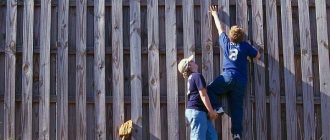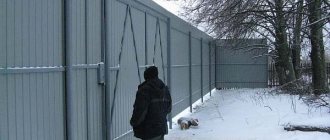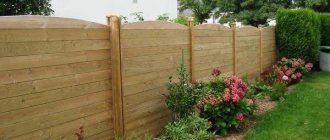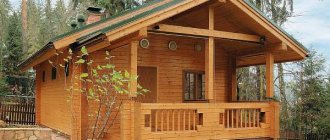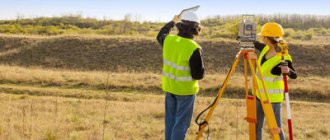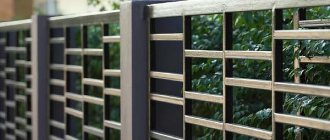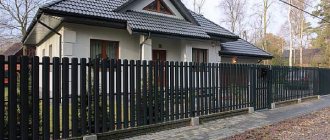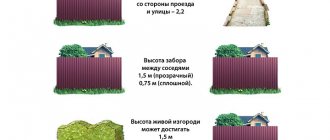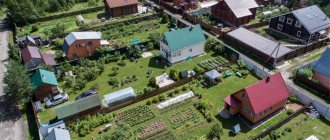There are many standards in construction, and fence height is no exception. It is almost impossible to imagine a summer cottage or a country house without such a fence. The height of the fence between neighbors plays an important role, so this indicator should be determined in advance in accordance with the law for 2020-2021.
Such a fence will definitely not please the neighbors
Law enforcement by neighbors
What height the fence should be is determined by the current legislation of the Russian Federation for SNT, individual housing construction, ONT, private household plots, DNP. In case of non-compliance with the pre-established standards, the owner may be required to demolish the fence through a judicial procedure. However, the majority believes that determining the height of a fence can be done purely individually, and do not want to listen to common sense. In this case, neighbors can act according to the law and report violations to the appropriate authorities.
Some people want to protect their property from prying eyes, and they do not agree to comply with fence height regulations. In this case, it is better to try to resolve the conflict on your own and talk to your neighbors in person. Perhaps they will agree to deviate from generally accepted rules or will even be interested in such actions.
SNiP recommendations for fence construction
The document states the following:
- The average height of the fence is up to 1.5 m (in some regions it is allowed to install up to 2.2 m).
- Blind fences that do not transmit light are allowed to be installed only on the street side to protect from the roadway or in special-purpose institutions.
- It is prohibited to build a fence directly on the border of two estates. The construction is carried out 0.5 m towards its territory.
- The light transmittance of the structure must be at least 50%.
But it is important to remember that in each region of the country the optimal fence height varies. If in the Moscow region the value is 1.5 m, then in the Volgograd region the maximum permissible is 2.2 m (provided that 0.75 m of the fence is blank, and the rest allows light to pass through well).
If you need to make a fence higher than 2 m in the private sector, in a country house or in a cottage community, you should obtain permission in advance from specialists in architectural services.
Individual housing construction: fence height
Before deciding what height to install the fence, you should read the regulatory documents for individual housing construction, private household plots and cottage villages. It clearly states the rules that can be applied in a specific situation. So what height of the fence between neighboring areas should be according to the law of 2021, SNiP 30-02-97 as amended in 2021 and SP 53.13330.2019 accurately determines the future dimensions of the fence:
- If we are talking about erecting fences that would border a roadway, then they can be made completely blank. The height of the fence should not exceed 2.2 meters.
- On all sides, any plot of land must be fenced with mesh (from a chain-link mesh), lattice or transparent fence, which would not shade the neighboring plot. Moreover, its height can be no more than one and a half meters.
Such a fence can be safely installed on the side of the roadway
It should also be noted that different restrictions may apply for each area, so advice should be sought from the relevant (local) architectural department before proceeding with the construction of fences.
Often local regulations differ from regional (federal) ones. Thus, they may cite the need to maintain electricity, water, or sewer systems.
In this case, it is recommended to come to an oral agreement with your neighbors, because not all owners of summer cottages grow plants that need natural light.
It is still recommended to sign a contract regarding the existing agreement.
Such a fence will not cause any complaints from neighbors
What rules should be followed when installing fences between neighboring areas:
- Based on SNiP, the gap between trees and shrubs from neighbors’ fences should be no less than the designation of one meter. If the height of the trees is average, then two meters, but if we are talking about tall trees, then four meters is allowed;
- between buildings and the boundary used for walking animals, the distance must be at least 4 m;
- between the restroom and the fence (including outbuildings for utility purposes) the distance can be less than 12 m;
- the distance between buildings and restrictions can be 1 m or more;
- the gap between the neighbor's house and the fence is at least three meters.
Permissible distances from the fence
What other dimensions should be taken into account?
After the construction of a summer house or any other structure intended for living, the distance to the nearest buildings should optimally be at least three meters. The fire distance will also play an important role when constructing any fence on a summer cottage. In the city, these norms are the first thing people pay attention to.
Where should home be?
Having proceeded to construction on the received plot of land, its owner tries to make the most of every meter. Legislative standards are not always taken into account. The law establishes rules according to which a house can be built at a certain distance from the fence of a neighboring plot.
To resolve this issue, there are the following rules:
| From home or other residential properties | There must be at least 3 meters to the fence. |
| From utility premises containing livestock or poultry | You need to leave more than 4 meters to the fence. |
| From technical rooms and garages | From 1 meter and more. |
You should also remember that trees of medium height should be planted at least 2 meters from the neighbors’ fence. For tall plants this distance increases to 4 meters.
The distance between the fence and the building may be smaller if the neighbors managed to agree on this. A compromise solution must be documented. In case of conflict, this will help confirm that you are right.
Distance between fences: SNT
First of all, such plots were used exclusively for gardening. But based on current regulatory documents, in addition to the fact that buildings and structures for residential purposes can be built on such sites, it is now possible to register there. At the same time, neighbors may have far from similar plans, so you will need to take into account the following additional requirements:
- On the side of the roadway, it is possible to install a brick (concrete) fence or any other solid fence without any height restrictions.
- The height of the fence between sections cannot exceed one and a half meters according to the law of the Russian Federation, as well as based on the current SNiP 30-02-97*, SP 30-102-99 and SP 53.13330.2019. Moreover, if the gardening partnership has its own charter and there are other instructions in this regard, then it is possible to increase this indicator.
- According to the law, the height of the neighbor's fence should not block sunlight from the plantings and cast shadows on the neighbor's plot, because this can significantly affect the yield.
What is the difference between the types of land TSN, SNT, ONT, DNP, individual housing construction, private plots, private plots?
The type of land, or rather the type of permitted use, is the first parameter that determines the rules for constructing fences.
There are 7 categories of land, in addition to the classic ones - settlements and agricultural purposes - forest lands, water resources, etc. are distinguished. For personal residential buildings, only 2 types are relevant:
- agricultural land;
- lands of populated areas.
For each category, types of permitted use are identified (Order of the Ministry of Economic Development of Russia dated September 1, 2014 N 540 (as amended on February 4, 2019).
They mean that the list of actions that the owner can carry out on a specific site is strictly limited.
The following types of permitted use are provided for the lands of settlements:
- Individual housing construction (IHC)
- Maintaining a personal subsidiary plot (LPH)
- Dacha construction (DNP)
For agricultural land:
- Maintaining a personal subsidiary plot (LPH)
- Dacha construction (DNP)
- Gardening (SNT, SNP)
Individual housing construction is a classic type that is used for individual housing construction. Plots with this status are intended for the construction of an individual residential building.
plot – personal subsidiary plot. Permits non-entrepreneurial agricultural activities on the site. The construction of a residential building is possible, provided that the site is located within a populated area.
Note ! In 2021, the horticulture and vegetable farming system was reformed. Most of the usual associations of summer residents have been cancelled. From January 1, 2021, only 2 types of partnerships operate: horticultural and vegetable gardening non-profit partnerships (SNT) and (ONT).
SNT is a horticultural non-profit partnership. Citizens unite in a non-profit organization to solve pressing problems of gardening.
ONT is a vegetable gardening non-profit partnership. It is also a non-profit association of citizens with the aim of jointly managing the process of gardening and vegetable gardening. It is prohibited to build residential buildings on the lands of such partnerships.
TSN is a partnership of real estate owners. It is an association of citizens into a non-profit organization for the purpose of joint management of any type of real estate. From January 1, 2019, all horticultural and gardening partnerships are a type of TSN. (FZ-217 dated July 29, 2021).
KP is a cottage community. Separate development of the territory with low-rise construction projects. Possible on any land where the construction of residential buildings is permitted.
Temporary fences and rules for their installation
During the construction process, teams of workers often erect temporary fences. Often we are talking about erecting a fence made of picket fence, chain-link mesh, or a wooden fence, but not a brick one. There is no need to build a foundation. However, to ensure the safety of residents of neighboring areas, a fence must be erected during reconstruction and construction work.
The photo shows a new construction site fence on the street in 2021.
Temporary fencing
If for some reason it is necessary to install something higher and more serious than a wooden fence, then after going through the procedure in accordance with the procedure established by law, you can install a more substantial fence, whose height can reach 3 meters or more (5 meters). The height of the corrugated fence in this case will be 3 meters or more.
Based on the current SNiP 3.01.01-85, all construction work is conditionally divided into three stages:
- Carrying out preliminary work to prepare the site allocated for construction or reconstruction. It is allowed to apply markings, construct a pit, prepare a site for a foundation, level the territory and dismantle unnecessary structures. Before leveling the area around the perimeter and installing a standard fence, you should obtain the appropriate permission.
- Reconstruction or construction of a residential building made of brick - in accordance with the current state standard (hereinafter referred to as GOST).
- After this, you can begin installing the fence at the dacha. It is possible to use corrugated sheets for a fence, fencing a summer cottage and installing gates (sometimes a gate is installed). Gates can be installed both at the beginning and at the end of the fence construction process.
Shoe guard is easy to install
But temporary fencing includes:
- Mobile structures. In this case, it is allowed to install fences with strong supporting structures, the height of which can reach 3 meters or more. It is on them that the entire load of the structure will be placed, including the weight of the gate. To improve durability, poles and gates are treated with primers and paints.
- Stationary fencing. Height may vary. Installation is acceptable in places where reconstruction or long-term construction is planned. Most often, preference is given to installing sectional fencing rather than a wooden fence. They are easy to dismantle and quite durable. Their height can reach three meters. They can be installed within a day and dismantled in an even shorter period of time. As a covering, a chain-link mesh and a galvanized profile are often used, from the remains of which gates are made. Coating with anti-corrosion compounds is encouraged.
Standards governing the construction of a fence on a private housing construction site
At the very beginning, before construction, it is important not to be lazy and contact local municipal institutions. All documents regulating the rules for site development are contained in the local administration, whose employees can connect you with a specialist in the field of architecture and urban planning.
If you want to find out how to solve your particular problem in 2021, please contact us through the online consultant form or call :
special document regulating the rules for constructing a fence between plots in our country.
All basic recommendations and rules can be found in SNiP (building codes and regulations).
Blind fencing and requirements for them
Example of a blind fence
A fence with an indicator of 5 meters or more can be erected simultaneously for several reasons, but often in order to:
- provide the required level of noise insulation (settlements are often located along highways and roads, and the first houses (townhouses with balconies) are fenced with a fence of 5 meters or less);
- ensure complete isolation between neighbors' houses.
Watch a video about the permissible height of fencing in the Moscow region according to the 2021 law.
However, it is still recommended to pay attention to the following recommendations:
- Between sections, the height of the fence should not exceed 1.5 meters. Everything above is only subject to written agreement with the neighbors.
- Blind hedges should not exceed 2.2 meters in size.
- This type of fence can be installed exclusively on the side of the roadway and the main facade of a residential building.
The following materials are often used for the construction of fences:
- slate;
- corrugated sheeting;
- brick;
- concrete;
- sheet material.
Corrugated fencing
Fire safety rules
If neighbors can agree on the height and type of fence between plots, then compliance with certain standards is mandatory. First of all, this concerns fire regulations.
Between two wooden houses you need to make a gap of 15 meters. These rules apply to all types of buildings, as well as fences and houses in neighboring areas.
- Due to frequent changes in legislation, information sometimes becomes outdated faster than we can update it on the website.
- All cases are very individual and depend on many factors. Basic information does not guarantee a solution to your specific problems.
That's why FREE expert consultants work for you around the clock!
- via the form (below), or via online chat
- Call the hotline:
- Moscow and the Region
- St. Petersburg and region
- Regions
What is the maximum height used in practice?
In addition to the fact that the fence serves as a fence, it also has some decorative functions. If you make a fence too high, the owner will be the first to suffer. Fences that are too high do not allow the sun's rays to penetrate into the territory of the cottages, making it dark and faceless. If the plot is ten acres or more, then the construction of barriers two meters high on the side of the roadway is allowed.
Also, the existing Law on Beekeeping states that if there is an apiary, hives and bees on the site, then this allows you to erect a continuous fence between neighbors 2 meters high. In 2021, 2021 and 2021, many property owners in rural communities are using this successfully.
The fence made of forged metal and polycarbonate is made taking into account all standards
The following rule should be followed: the higher the fence you plan to make, the more transparent the material should be used.
In remote areas, you should take care of ventilation yourself (holes at the level of fifteen centimeters from the ground level). If this is not done, then the constant dampness will not go away, after which mustiness and mold will appear everywhere. If the owner has 20 acres, then it is allowed to erect a fence 3.5 meters high in agreement with the local administration.
Where to complain
If a fence is being erected or has already been erected between areas that violates legal norms, the citizen whose rights have been infringed may complain. This should be done after the issue has not been resolved peacefully. In this case, you need to go to court.
The following documents must be attached to the statement of claim:
- land title document;
- cadastral plan;
- land survey plan;
- diagram of both sections;
- other documents requested by the court.
The court's decision depends only on the evidence presented, so such a step can only be taken if the plaintiff is completely confident that he is right and can confirm it with documents.
This is interesting: State duty for dividing a land plot
What to do if your neighbors have installed a high fence
When, with the appearance of a blank fence on the part of neighbors, the normal life of the residents of the site is disrupted, then you can defend your rights like this:
- The owners of TSN lands must submit a written complaint about violation of the partnership charter.
- Additionally, file a claim in court for a violation under Article 304 of the Civil Code of the Russian Federation “Protection of the rights of the owner from violations not related to deprivation of property.”
It is necessary to provide evidence of how the constructed fence causes harm. If it creates shading of the area, which leads to a decrease in yield and rotting of plants, then you need to take photos before and after installing the fence.
The result of a court decision depends on the quantity and quality of the evidence base.
You should not rely on SNiP, since the standards are advisory in nature and will be ineffective during legal proceedings.
Procedure for processing documents
To ensure that your high fence is installed legally and does not have to be demolished, be sure to follow all bureaucratic rules before construction begins:
- Document the land surveying between your and your neighbor's land in the BTI;
- Record the demarcation line in a photo or video, clearly marking it in advance with tape or slats dug into the ground;
- Erect a low fence in accordance with SNiP at the permitted distance from the border of the plots. To strengthen your position in future disputes, you can insure your fence;
- Step back 1.1 m or more from the first fence and begin building a tall fence. Upon completion of the work, be sure to record the distance between the fences in the photo (take a close-up photo with a ruler or tape measure);
- Save all receipts for the purchase of building materials for the construction of a large fence.
There is no way to do without a small decorative fence, because if it is missing, neighbors will be able to legally enlarge their plot and still make claims against you.
